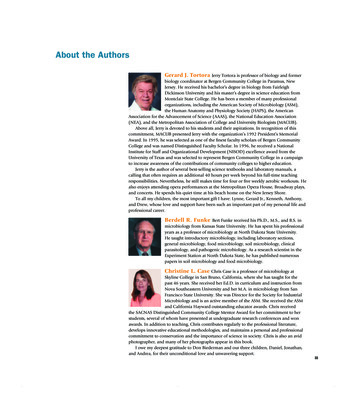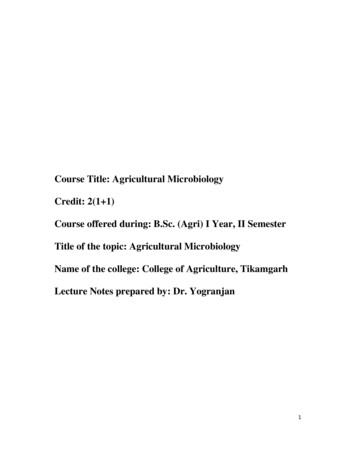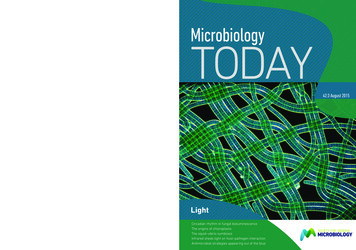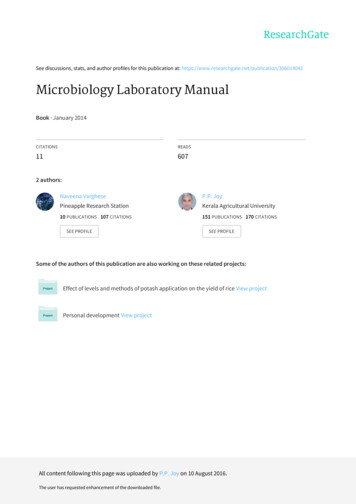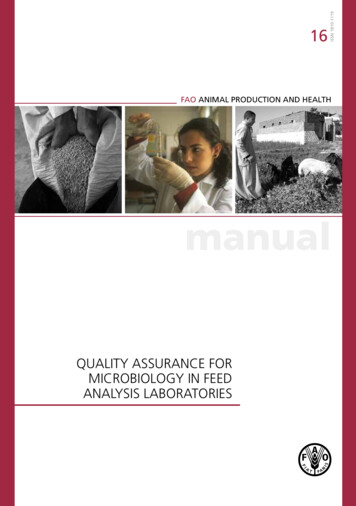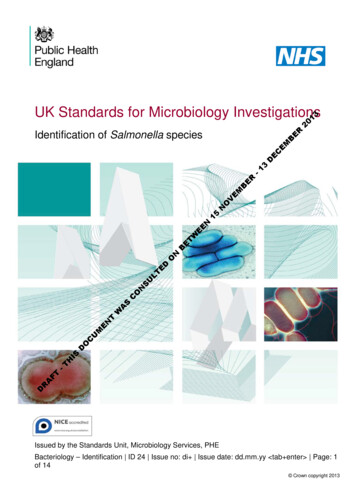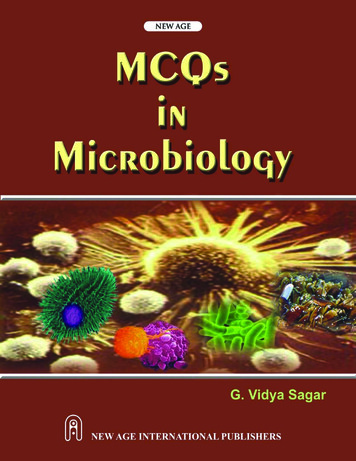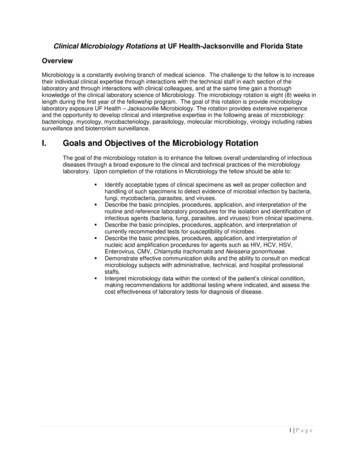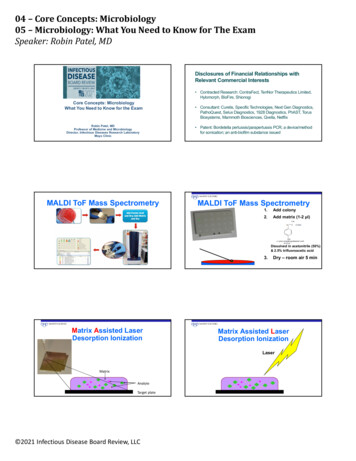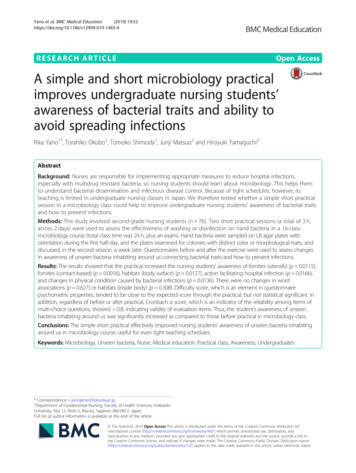
Transcription
Yano et al. BMC Medical Education(2019) ARCH ARTICLEOpen AccessA simple and short microbiology practicalimproves undergraduate nursing students’awareness of bacterial traits and ability toavoid spreading infectionsRika Yano1*, Torahiko Okubo2, Tomoko Shimoda1, Junji Matsuo2 and Hiroyuki Yamaguchi2AbstractBackground: Nurses are responsible for implementing appropriate measures to reduce hospital infections,especially with multidrug resistant bacteria, so nursing students should learn about microbiology. This helps themto understand bacterial dissemination and infectious disease control. Because of tight schedules, however, itsteaching is limited in undergraduate nursing classes in Japan. We therefore tested whether a simple short practicalsession in a microbiology class could help to improve undergraduate nursing students’ awareness of bacterial traitsand how to prevent infections.Methods: This study involved second-grade nursing students (n 76). Two short practical sessions (a total of 3 h,across 2 days) were used to assess the effectiveness of washing or disinfection on hand bacteria in a 16-classmicrobiology course (total class time was 24 h, plus an exam). Hand bacteria were sampled on LB agar plates withorientation during the first half-day, and the plates examined for colonies with distinct color or morphological traits, anddiscussed, in the second session, a week later. Questionnaires before and after the exercise were used to assess changesin awareness of unseen bacteria inhabiting around us connecting bacterial traits and how to prevent infections.Results: The results showed that the practical increased the nursing students’ awareness of fomites (utensils) (p 0.0115),fomites (contact-based) (p 0.0016), habitats (body surface) (p 0.0127), action facilitating hospital infection (p 0.0166),and changes in physical condition caused by bacterial infections (p 0.0136). There were no changes in wordassociations (p 0.627) or habitats (inside body) (p 0.308). Difficulty score, which is an element in questionnairepsychometric properties, tended to be close to the expected score through the practical, but not statistical significant. Inaddition, regardless of before or after practical, Cronbach α score, which is an indicator of the reliability among items ofmulti-choice questions, showed 0.8, indicating validity of evaluation items. Thus, the student’s awareness of unseenbacteria inhabiting around us was significantly increased as compared to those before practical in microbiology class.Conclusions: The simple short practical effectively improved nursing students’ awareness of unseen bacteria inhabitingaround us in microbiology course, useful for even tight teaching schedules.Keywords: Microbiology, Unseen bacteria, Nurse, Medical education, Practical class, Awareness, Undergraduates* Correspondence: r-yano@med.hokudai.ac.jp1Department of Fundamental Nursing, Faculty of Health Sciences, HokkaidoUniversity, Kita 12, Nishi 5, Kita-ku, Sapporo 060-0812, JapanFull list of author information is available at the end of the article The Author(s). 2019 Open Access This article is distributed under the terms of the Creative Commons Attribution 4.0International License (http://creativecommons.org/licenses/by/4.0/), which permits unrestricted use, distribution, andreproduction in any medium, provided you give appropriate credit to the original author(s) and the source, provide a link tothe Creative Commons license, and indicate if changes were made. The Creative Commons Public Domain Dedication o/1.0/) applies to the data made available in this article, unless otherwise stated.
Yano et al. BMC Medical Education(2019) 19:53BackgroundPrecautions taken during contact between patients andmedical staff and the cleanliness of high-contact surfacesin hospitals are critically important in controllinghospital-acquired infections (HAIs) [1]. Bacterial contamination of surfaces in hospitals surfaces occursthrough contact with a range of individuals includingvisitors, patients, and staff, despite extensive measures topromote cleanliness, including determination of aerobiccolony-forming units or detection of ATP on surfaces[2–10]. Nurses are principally responsible for implementing appropriate measures to reduce hospital infections, especially with multidrug resistant bacteria [11].Improving awareness of unseen bacteria ubiquitouslyinhabiting around us is directly linked to controllingHAIs. Meanwhile, the contents of microbiology coursesin nursing classes are generally based on knowledge because the course lacks in practical work such as formingbacterial culture or colony observation. It is thereforereasonable for nursing students to learn about its practice, at an early stage in their training, undoubtedly helping them to recognize unseen bacteria potentiallytransmitting everywhere via medical staff or fomites.However there is no consensus about the best way toteach management of standard precautions and precautions based on disease transmission mechanisms tonursing students or other health care students [12].Although the homogeneous and systematic educationsystem promises to provide high quality classes for thosestudents [13], there is, however, a concern about thepoor integration of practice with critical thinking, because of busy class schedules and a focus on theory inlessons [14]. Unfortunately, microbiology course is noexception to this, and inadequate awareness of bacterialtraits and how to protect against infection, in particularlacking practical work, is a serious issue. It is thereforeconsidered important to provide effective practical training in microbiology course for nursing students at anearly stage of their education, to help them to recognizeunseen bacteria around us and understand how to avoidspreading infection. No adequate practical demonstrations in microbiology course have been provided fornursing students, especially undergraduates. Furthermore, it is well accepted that a theoretical frameworkthat can foster experiential learning consisting of a cyclewith concrete experience, reflective observation, abstractconceptualization and active experimentation, can generate awareness strongly [15].In this study, we therefore developed a short and simple practical program (a total of 3 h, over 2 days) that iseasily embedded in microbiology courses (which cover atotal of 24 h class time plus an exam, and a period of 16days). We used questionnaires to assess whether thispractical program could improve undergraduate nursingPage 2 of 7students’ awareness of bacterial traits and how to avoidspreading infection.MethodsStudy sampleThe study involved second-grade nursing students(n 76) from the Faculty of Medicine (Health Sciences),at Hokkaido University. All elements were part of theregular microbiology course.Study designFigure 1 shows the design of the study. Two short practical sessions (in total, only 3 h, over 2 days, 7 days apart)were used to demonstrate the effectiveness of hand hygiene by washing hand with or without disinfectants(70% alcohol or waterless antiseptic agent) on eliminating hand bacteria. These sessions were part of a basicmicrobiology course for the nursing students (16 classestotaling 24 h, over the period from April to July, plus anexam). The course covered an introduction, bacterialecology, structure, growth and metabolism, viruses,fungi, protozoa, disinfection and sterilizing, antibiotics,infections and host defenses, and infectious diseases.The sampling of hand bacteria on an LB (Luria-Bertani)agar plate with orientation took place one day (Fig. 1,“Day 1”), and seven days’ later, the students examinedthe plates for colonies with distinct color or morphological traits, then discussed their findings (Fig. 1, “Day2”). For the nursing students, questionnaires (see below)were used to assess changes in awareness of microbiology before and after the practical sessions.LB agar plate culture and colony observationAll the agar plates were cultured for 7 days at roomtemperature. After being carefully sealed with laboratorytape, the cultured plates were carefully observed in thelecture room to assess the color, size, gloss, and numberof colonies. Since the sessions took place in a generallecture room, which did not meet specified biosafetylevels, the plates could not be opened for observation. Itwas, however, considered more convenient to carry outthe practical in a general lecture room.Questionnaires and data expressionsAs mentioned above, the questionnaires for the nursingstudents were administered twice, before and after thepractical sessions. The questionnaire included sevengeneral questions (Q1–7), each with eight answer options. The questions covered various aspects of bacteriaincluding word associations, changes in physical condition as a result of infection, fomites (utensil orcontact-based material), bacterial habitats (body surfaceor inside), and actions facilitating hospital infections (seeTable 1). Each of the questions allowed multiple
Yano et al. BMC Medical Education(2019) 19:53Page 3 of 7Fig. 1 Arrangement of the practical of hand washing with visualizing hand bacteria into microbiology course for nursing students andits evaluationanswers. For each question, data were expressed as “Improved value Δ%”, calculated as “rate after the practical” “rate before the practical” . Also, cumulative scoreof individual students for each of the items in questionnaire were used for estimating psychometric properties(See below).Estimation of psychometric properties including scoremean, score distribution, Cronbach α score, and difficultyindex (DI)First of all, score mean and its distribution were calculated for estimating Cronbach α score, which is an indicator for estimating the reliability of multi-choicequestions based on comparing the score of distributionamong questionnaire’s items [16]. The Cronbach α scorewere estimated by a protocol with an equation [α (k/k–1)(1–sum of variances of all items/total test variance)]as described previously [16]. In this equation,“k” showsthe number of items in questionnaire. Also, to confirmthe validity of “difficulty” among items in questionnaire,DI was calculated by a protocol with an equation (number of expected answers/number of all student’s answers)as described previously [16], and then compared amongexpected answer score, pre-practical score, andafter-practical score. All calculations were conductedusing Excel for Mac (2015) with Statcel3C.
Yano et al. BMC Medical Education(2019) 19:53Page 4 of 7Table 1 Questionnaire items and those choicesQuestionnaire items (Q1 to 7): those choices (answers)a/ “”bQ1. ‘What words images from le painheartbeattrain ide inal cavitypharynxsumo wrestlinghandshakehand-washingfloor button inelevatortoilet seat withbidet functionsmealintravenous dripassistanceblood samplingQ2. ‘What physical condition changes images from “bacteria”?’pneumoniavomitingdermatitisQ3. ‘What fomites (utensils) images from “bacteria”?’TV remote controllerPC keyboardcar handleQ4. ‘What habitats (body surface) image from “bacteria”?’navelbehind the earshairQ5. ‘What habitats (inside body parts) image from “bacteria”?’eyeballuterusstomachQ6. ‘What fomites (contact based) image from “bacteria”?’stethoscopetoilet seatpublic telephoneQ7. ‘What actions facilitating hospital infections image from “bacteria”?’blood ltationaFor questions that allow multiple answersFor estimating Cronbach’s α score, “correct answer” that we expected are settled up into each of the Questions. Please see the legend of Fig. 3bStatistical analysisComparison between “rate after the practical” and “ratebefore the practical” was performed using statistical analysis with two-way ANOVA. Comparison among DIswas conducted using a Bonferroni/Dunn test. Additionally, diffract score(score distribution) was estimatedusing a function with VAR(x) installed into Excel.P-value of less than 0.05 was considered significant.Cronbach’s α score of more than 0.8 was considered ashaving significant validity.ResultsThe practical’s impact on awareness of unseen bacteriaaround us among nursing studentsTo assess whether the practical program had an impacton awareness of unseen bacteria inhabiting around usamong the nursing students, we compared their awareness before and after the practical sessions. Figure 2shows that awareness was significantly increased of fomites (utensils) (p 0.0115), fomites (contact-based) (p 0.0016), habitats (body surface) (p 0.0127), actions facilitating hospital infection (p 0.0166), and physicalchanges in condition caused by bacterial infections (p 0.0136). There were no changes in word associations (p 0.627) or habitats (inside body) (p 0.308). Thus, theresults therefore indicated that even a simple short practical program in microbiology can have a strong impacton increasing awareness about microbiology in particular in terms of unseen bacteria inhabiting around usamong nursing students.Validity of items in questionnaire on estimating thechanges in awareness via practicalTo verify whether the changes in awareness were ameaningful improvement among nursing students, weestimated psychometric properties including mean, distribution of scores, Cronbach α score and DI. As shownin Fig. 3 (above panel), Cronbach α score on the questionnaires showed 0.8 (before practical, 0.904; afterpractical, 0.890), indicating validity of evaluation itemsin questionnaire. Furthermore, we found that DI tendedto be close to the expected score through the practical,but not statistical significant. The result was corresponded to those of awareness in the questionnaires,verifying the items in questionnaire on estimating thechanges in awareness via practical.DiscussionThe undergraduate education system for nurses in Japan,including in microbiology course, lacks integration ofpractical sessions with critical thinking, because of busyclass schedules and a focus on theoretical teaching [13,14]. Nurses, however, play a key role in preventinghospital-acquired infections, and it is therefore important to provide effective microbiological practical sessionsfor nursing students at an early stage in their education.We developed a short, simple practical program that iseasily embedded in a standard microbiology course. Weused questionnaires to assess whether the practical couldbe useful in improving undergraduate nursing students’awareness of bacterial traits and how to prevent
Yano et al. BMC Medical Education(2019) 19:53Page 5 of 7Fig. 2 Impact of the practical on awareness of unseen bacteria inhabiting on their hand among nursing students. The x- and y-axes show objectnames and changes after the practical. For each question, data were expressed as Improved value Δ%, comparing the rate after the practical withthe rate before. They were compared using statistical analysis with two-way ANOVA. P-value of less than 0.05 was considered significantinfections. We found that a simple short practical program in microbiology course can have a strong impacton increasing awareness about unseen bacteria inhabiting around us among nursing students. This suggeststhat it could be used even in classes with tight schedules,and could therefore be an appropriate measure to helpreduce hospital infections.At this stage in their training, the nursing students hadlearned only basic chemistry, biology and techniques innursing care, so had limited knowledge and skills. The practical therefore simply consisted of hand sampling on an LBagar plate, and the observation of colonies formed on theplates. No specified biosafety laboratory room or microscopes were required, which meant that the practical couldtake place in a general lecture room. The practical took only3 h across two sessions, so the time consumption was notexcessive. It also required very little preparation, becauseeach student only required two agar plates, so the burden onstaff was limited, and the expense was low (less than 100 yenper student). It could therefore be embedded into any microbiology course at very little cost. Furthermore, the assessment with Cronbach α scores and DIs verified the reliabilityof items in questionnaire on estimating the changes inawareness via practical, suggesting that it was a meaningfulway to improve awareness of microbiology in particular unseen bacteria inhabiting around us among nursing students.As expected, comparing the questionnaires showedthat the practical improved awareness of unseen bacteria
Yano et al. BMC Medical Education(2019) 19:53Page 6 of 7Questionnaire numberPsychometric propertiesPre practicalStudent numbersScore averageScore SDScore distributionAfter practicalStudent numbersScore averageScore SDScore 946.3992.6533.9684.0170.9040.8901.2Difficulty index (DI)10.8Expected DI0.6Observed DI (pre)Observed DI (after)0.40.20Q1Q2Q3Q4Q5Q6Q7QuestionnaireFig. 3 Validity of items in questionnaires on estimating changes in awareness via practical. Upper panel shows psychometric properties includingmean score, distribution scores, and Cronbach’s α score. Score distributions show diffract values (See the Methods section). Cronbach’s α score ofmore than 0.8 was considered as having significant validity. Lower panel shows the comparison of ID (difficulty index) among “Expected DI”(theoretically expected) (White bar), “Observed DI (pre)” (before the practical) (Blue bar), and “Observed DI (after)” (after the practical) (Red bar).The DIs were compared using a Bonferroni/Dunn test, but no significant difference was seen. “Q1–7” shows the items of questionnaires. SeeTable 1. Additionally, for estimating Cronbach’s α scores, the “correct answers” provided against each of the questions are settled up into each ofthe Questions as underlined items in Table 1inhabiting around us among nursing students. Awarenesswas significantly increased of fomites (utensils andcontact-based), habitats (body surface), actions facilitatinghospital infection, and physical changes in condition causedby bacterial infections, but not in word associations or habitats (inside body). It is well-known that visualizing structures or materials can improve students’ awareness ofspecific lecture topics, enabling them to better understandlectures [17, 18]. It has, for example, been reported that theoral microbiology lab curriculum appears to improve thequality of oral medicine education and help to cultivatehigh-quality innovative medical talents [19]. Experientialcourses with an emphasis on patient-physician/dentistcommunication plays a significant role in early on duringpre-clinical medical and dental studies [20]. These studiestherefore suggest that a combined lecture and practical approach could improve understanding of specific subjects.The observation of colonies may not be surprising, but being able to visualize previously-unseen life through the observations could enable the students to make a connectionbetween those images and more familiar objects such asTV remote controls or stethoscopes. However, word associations and the inside of the body are harder to connect tothe observed images, which may explain why the practicalhad no impact on the awareness of these areas among thenursing students. This may explain the necessity of advanced practical for acquiring deeper knowledge about infectious diseases to nursing students.
Yano et al. BMC Medical Education(2019) 19:53Page 7 of 7ConclusionAltogether, we conclude that the simple and short practical in microbiology course offered to nursing studentseffectively improved their awareness of unseen bacteriainhabiting around us. Meanwhile, this practical has alimitation that this study provided only the second-gradenursing students class, lacking comparison to those ofother nursing courses. Further study should be neededto clarify our conclusion.5.AbbreviationsANOVA: Analysis of variance; ATP: Adenosine triphosphate; DI: Difficultyindex; HAIs: Hospital-acquired infections6.2.3.4.AcknowledgementsWe thank the staff members of the Departments of Medical LaboratoryScience and Nursing, Faculty of Health Sciences, Hokkaido University, fortheir assistance throughout this study.We thank Melissa Leffler, MBA, from Edanz Group (www.edanzediting.com/ac) for editing a draft of this manuscript.8.FundingThis work was funded by operating support funds, Hokkaido University.9.Availability of data and materialsThe datasets generated and/or analyzed during the current study areavailable from the corresponding author on reasonable request.7.10.11.Authors’ contributionsThe project was conceived by RY, TO, TS, JM and HY. The preparationsincluding making agar plates and questionnaires were performed by RY, TO,TS, JM, and HY. The lectures for students were performed by RY and HY.Statistical analysis was performed by RY. The draft paper was critically editedby RY, TO, TS, JM and HY. HY wrote the paper. All authors approved the finalmanuscript.Ethics approval and consent to participateEthics approval was obtained from the Ethics Committee of the University ofHokkaido (reference number 17–75). The participant consent was verbal. Wereceived ethics committee approval for verbal consent. All participants wereinformed of the purpose of the study. They were entirely voluntary and wereassured that the data would be treated with confidentiality and anonymity.12.13.14.15.16.17.Consent for publicationNot applicable.Competing interestsThe authors declare that they have no competing interests.18.19.Publisher’s NoteSpringer Nature remains neutral with regard to jurisdictional claims inpublished maps and institutional affiliations.Author details1Department of Fundamental Nursing, Faculty of Health Sciences, HokkaidoUniversity, Kita 12, Nishi 5, Kita-ku, Sapporo 060-0812, Japan. 2Department ofMedical Laboratory Science, Faculty of Health Sciences, Hokkaido University,Sapporo, Japan.Received: 8 November 2017 Accepted: 1 February 2019References1. Siegel JD, Rhinehart E, Jackson M, Chiarello L. The healthcare infectioncontrol practices advisory committee: Management of Multidrug-ResistantOrganisms in Healthcare Settings. Atlanta: centers for disease control and.Prevention. 2006.20.Samore MH, Venkataraman L, DeGirolami PC, Arbeit RD, Karchmer AW.Clinical and molecular epidemiology of sporadic and clustered cases ofnosocomial Clostridium difficile diarrhea. Am J Med. 1996;100:32–40.Hayden MK, Bonten MJ, Blom DW, Lyle EA, van de Vijver DA, Weinstein RA.Reduction in acquisition of vancomycin-resistant Enterococcus afterenforcement of routine environmental cleaning measures. Clin Infect Dis.2006;42:1552–60.Hayden MK, Blom DW, Lyle EA, Moore CG, Weinstein RA. Risk of hand orglove contamination after contact with patients colonized withvancomycin-resistant Enterococcus or the colonized patient’s environment.Infect Control Hosp Epidemiol. 2008;29:149–54.Martinez JA, Ruthazer R, Hansjosten K, Barefoot L, Snydman DR. Role ofenvironmental contamination as a risk factor for acquisition of vancomycinresistant enterococci by in patients treated in a medical intensive care unit.Arch Intern Med. 2003;163:1905–12.Huang SS, Datta R, Platt R. Risk of acquiring antibiotic-resistant bacteria fromprior room occupants. Arch Intern Med. 2006;166:1945–51.Goodman ER, Platt R, Bass R, Onderdonk AB, Yokoe DS, Huang SS. Impact ofan environmental cleaning intervention on the presence of methicillinresistant Staphylococcus aureus and vancomycin-resistant enterococci onsurfaces in intensive care unit rooms. Infect Control Hosp Epidemiol. 2008;29:593–9.Wu HM, Fornek M, Schwab KJ, Chapin AR, Gibson K, Schwab E. A norovirusoutbreak at a long term–care facility: the role of environmental surfacecontamination. Infect Control Hosp Epidemiol. 2005;26:802–10.Boyce JM. Environmental contamination makes an important contributionto hospital infection. J Hosp Infect. 2007;65(Suppl. 2):50–4.Watanabe R, Shimoda T, Yano R, Hayashi Y, Nakamura S, Matsuo J, YamaguchiH. Visualization of hospital cleanliness in three Japanese hospitals with atendency toward long-term care. BMC Res Notes. 2014;7:121.Gail C, Field KW, Simpson T, Bond EF. Clinical nurse specialists and nursepractitioners: complementary roles for infectious disease and infectioncontrol. Am J Infect Control. 2004;32(4):239–42.Soledad M, Ramirez K. Influence of undergraduate nursing student teachingmethods on learning standard precautions and transmission-basedprecautions: experimental research. Nurse Educ Today. 2018;61:101–5.Japanese Nursing Association. URL: https://www.nurse.or.jp/jna/english/.Kawashima A. Critical thinking integration into nursing education andpractice in Japan: views on its reception from foreign-trained Japanesenursing educators. Contemp Nurse. 2003;15(3):199–208.Yardley S, Teunissen PW, Dornan T. Experiential learning: AMEE Guide No.63. Med Teach. 2012;34(2):e102–15.Syed HA, ACa P, Kenneth GR. Validity and reliability of scores obtained onmultiple-choice questions: why functioning distractors matter. Journal ofthe Scholarship of Teaching and Learning. 2016;16(1):14.Jaswal SS, O'Hara PB, Williamson PL, Springer AL. Teaching structure:student use of software tools for understanding macromolecular structurein an undergraduate biochemistry course. Biochem Mol Biol Educ. 2013;41(5):351–9.Haidegger T, Nagy M, Lehotsky A, Szilágyi L. Digital imaging for theeducation of proper surgical hand disinfection. Med Image ComputComput Assist Interv. 2011;14(Pt 3):619–26.Nie M, Gao ZY, Wu XY, Jiang CX, Du JH. Evaluation of oral microbiology labcurriculum reform. BMC Medical Education. 2015;15:217.Alvarez S, Schultz JH. A communication-focused curriculum for dentalstudents – an experiential training approach. BMC Medical Education. 2018;18:55.
Background: Nurses are responsible for implementing appropriate measures to reduce hospital infections, especially with multidrug resistant bacteria, so nursing students should learn about microbiology. This helps them to understand bacterial dissemination and infectious
